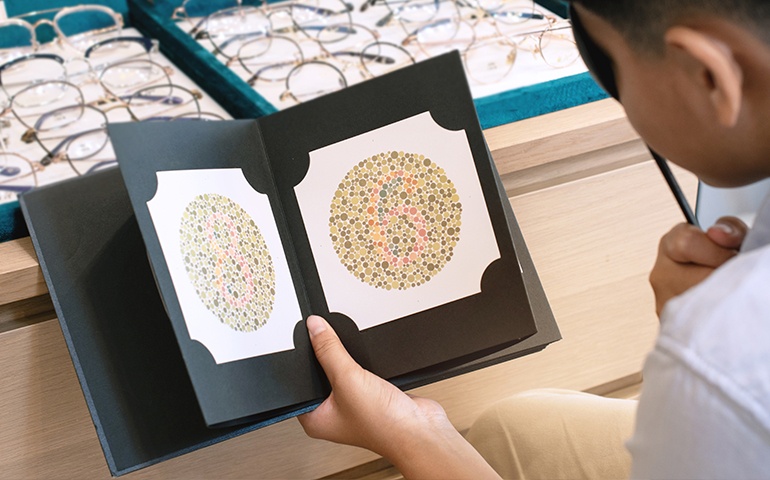
What is colour vision deficiency?
Colour vision deficiency, also referred to as colour blindness, describes the condition where a person is unable to see the full spectrum of colours.
We see colours because our eyes respond to the different wavelengths of light they give off, for example, shades of blue radiate short wavelengths, green shades radiate medium wavelengths of light and shades of red give off long wavelengths of light.
The retina, located at the back of the eye, contains photoreceptors called rods and cones that are sensitive to light and colour, respectively. They send specific chemicals through the optic nerve to our brain, in response to different wavelengths, which allows us to see colours.
If the photoreceptors are missing, or not functioning properly, certain colours can’t be processed by the brain, leading to colour vision deficiency.
Types of colour vision deficiency
Those with regular colour vision are called trichromats, when all three types of cones in your retina are functioning properly to detect colour.
Complete loss of colour vision is called achromatopsia, where those affected can only see in monochromatic vision of black, greys and white.
However, the complete inability to see any colour is extremely rare, most people with colour vision deficiency are still able to see some shades of colour.
Dichromacy
Dichromatic colour vision is a type of colour vision deficiency, where only two types of cones function. This means that those affected cannot see one specific section of colour, whether this is the light spectrum of red, green or blue.
The three different types of dichromacy are:
- Protanopia: the red cone is absent in the affected person
- Deuternopia: the green cone is absent in the affected person
- Tritanopia: the blue cone is missing in the affected person
For example, those with protanopia often confuse greens and reds with brown, and deuteranopes mix up pinks and purples with shades of grey. Tritanopia is less common, those affected often confuse blue with green, or replace certain shades of blue with grey.
Anomalous Trichromacy
Some people have irregular trichromatic vision, which means that one type of cone does not process wavelengths of lights correctly. The specific cone is not missing, but rather less sensitive, therefore the colour vision deficiency is milder.
The three types of anomalous trichromacy are:
- Protanomaly: a reduced sensitivity to red light
- Deuteranomaly: a reduced sensitivity to green light
- Tritanomaly: a reduced sensitivity to blue light

Causes for colour vision deficiency
In some cases, the inability to see the full spectrum can be caused by certain diseases, or specific medication to treat medical conditions or infections. These can affect your retina or optic nerve which, in turn, can affect your ability to recognise colours.
However, in most instances colour vision deficiency is genetically inherited.
Genetics
Red-green colour deficiency is typically a genetic condition affecting both eyes and already present at birth. Difficulty in telling blue and yellow apart is also, in most cases, caused by genetics.
Who can be affected?
Anyone can be affected by colour vision deficiency, however, the function for colour vision is carried on a X-linked recessive gene, therefore colour vision deficiency affects men a lot more than women. This is because women have two X-chromosomes, both of which would need to be impacted for the condition to be passed on.
Studies suggest that worldwide 1 in 12 men have colour vision deficiency, but only 1 in 200 women are affected.
Can you suddenly lose colour vision?
If you notice your colour vision changing the cause is typically a health condition or medication.
If you have a medical condition or eye disease that affects the retina or optic nerve, it is possible that your colour recognition may be affected. This also applies to medication used to treating autoimmune diseases, high blood pressure or certain infections. In these instances of reduced colour recognition, either one or both eyes can be affected.
Speak to your optometrist or GP if you notice any changes to your colour vision.

Detection of colour vision deficiency
Colour vision deficiency is usually first noticed in early childhood, during eye screening programmes at school or the first sight test.
If you suspect that your child has a colour deficiency, schedule an appointment with an optometrist. They can examine colour perception by showing the patient specific pictures made up of dots, with numbers or shapes in them (Ishihara plates). Those with colour vision deficiency will have difficulties detecting the numbers or shapes or won’t be able to see them at all.
Colour vision test at home
You can test your colour vision accuracy online through colour vision charts.
This may not accurately determine which type of colour vision deficiency you have or how severe this is, but the tests will show whether your eyes process the full spectrum of colour.
Treatment options for colour vision deficiency
It is possible to regain your full colour vision, if the deficiency was caused by an illness or medication that affected your photoreceptors. Inherited colour vision deficiency can unfortunately not be cured.
However, scientists are researching treatment options for retinal conditions such as colour vision deficiency. It is possible that treatment options through gene replacement techniques may become available in the future.
Colour vision glasses
There are colour vision glasses available on the market, which provide a coloured filter for a higher contrast between various colours. However, these glasses won’t offer a complete restoration of full colour vision, but rather make it easier for those with reduced colour vision to differentiate between shades of colour.